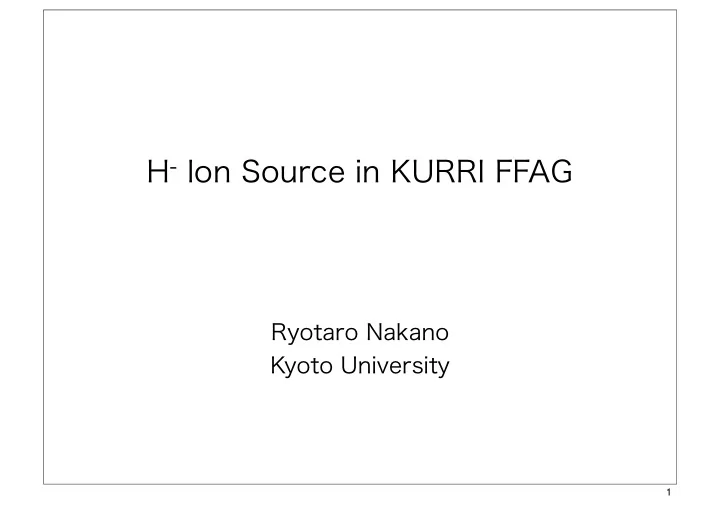

H - Ion Source in KURRI FFAG Ryotaro Nakano Kyoto University 1
Contents • New H- Injection Line • Introduction of H- Ion Source • Cusp & Filter Field • TOSCA Model • Summary • Future Plan 2
New H- Injection Line H- Ion Source linac Charge Exchange ・ Particle : H - ・ Beam Energy : 11MeV ・ Pulse Width(Max) : 100µs Main Ring ・ Current(Max) : 3.12 × 10 12 ppp ・ Pulse Repetition : 30Hz • Energy : 11MeV-150MeV • Revolution Frequency : 1.582 MHz(~0.62µs/turn) • RF Voltage : 2kV Charge of the Beam from linac is exchanged at that point. Try to optimize the H- ion source 3
H- Ion Source There are two kinds of ion source. Surface Production Volume Production power efficiency high low Gas efficiency high low Cesium injection necessary unnecessary Beam Brightness low high The first invented ion source is surface production type but recently volume production type is invented. In a surface production type , an efficiency of creating H- ion is high but cesium injection is necessary , so the emittance of the extracted ion beam becomes larger. While , in a volume production type , cesium injection is not necessary but if a little cesium is injected , high current is obtained. The Beam emittance relatively becomes smaller. So , we use an ion source of volume production type. 4
H- Ion Source in KURRI FFAG Enlargement Solenoid Magnet Linac H 2 gas Plasma creation room Beam Chopper • Particle : H- H- extraction system • type : Volume Production • Extraction Energy : 30keV • Repetition Rate (max): 200Hz • Pulse width (max) : 100µs Target: Up to 10mA • Beam Current : 5mA(peak) 5
Cross Section of H - Ion Source H2 Gas BCDEGHé Filament 1234$5 linac Arc Chamber )*+,-$.* Electrode LWz{ Vacuum Pomp Port èêë$Oníë*5 ! A-3 3 "#$% &'! "#$%&'! The filament is in the arc chamber. injecting H2 gas into arc chamber , plasma is created by arc discharge. Negative hydrogen ion is extracted by electric field which electrode create. 6
Volume Production Permanent Magnet (for filter field) Permanent Magnet (for cusp field) Plasma Electrode Plasma Plasma Region A Region Negative Ion B H 2 Filament * (v) + H 2 e − ( < 1eV) H 2 + e − ( > 5eV) → H 2 * (v) + e − → H − + H * ( v ) : excitation hydrogen molecule H 2 To separate a plasma region A and B , set the permanent magnets as filter field In the plasma region A , high electron temperature is needed to excite the hydrogen molecule. In the plasma region B , low electron temperature is needed to capture an electron in the excitation hydrogen molecule. Through these processes , a negative hydrogen is created 7
Cusp and Filter Field S N N N S S S S N N Permanent magnet for filter field N N S N S S S N S Filament N N N N S S S S N S S N N S N N S S S N N S N If the magnetic field strength is not suitable , high temperature electron may go into the low temperature region. In this case produced H- ion may be detached by the high temperature electron. The optimization of the magnetic field strength is needed. 8
Present Condition 6 84 60 24 Ø12 6 44 18 150 56 8 110 6 8 91 18 12 Ø15 Filter magnet Tip of filament 30° Plasma Electrode B Filter strength =B· l l 68.5 110 Filter magnet Filter strength of the magnets is given by integral from the tip of a filament to plasma electrode. Using TOSCA , 3D magnetic model is created. 9
TOSCA Model Cusp Magnets Filter Magnets TOSCA model Magnetic field made by cusp magnet 10
TOSCA Model Calculate the filter strength Using B ⊥ TOSCA along the red line x The red line is center of arc chamber. B is Magnetic strength on the x direction and in a vertical to a x axis. 11
Current Condition Tip of the Filament Plasma Electrode B[T] Filament x[mm] B· l=128 Gauss· cm In this case , emitted electrons feel a magnetic potential. This causes efficiency of the creating plasma may become worse. So, try to expand the plasma chamber to reduce the magnetic strength at the filament. 12
Optimization 6 18 91 8 6 110 8 150 Ø12 18 44 6 56 24 60 84 12 Ø15 Ø15 12 8 6 150 18 44 6 60 84 24 18 8 131 150 6 Ø12 A B Top of filament Top of filament Plasma Electrode 30° 30° Plasma Electrode 40mm 40mm 68.5 110 150 expand the arc chamber by 40 mm. 13
After optimization A Tip of the Filament Plasma Electrode Filament is near zero cross line. B[T] Compared with previous condition , this filament place is better. Filament x[mm] B A : B· l=128 Gauss· cm 40mm Tip of the Filament Plasma Electrode B[T] B : B· l=188 Gauss· cm Filament This difference is not understood bad or good. x[mm] 14
Summary • Introduction of the two kinds of ion source >Our using source is volume production type. • Magnetic field calculation in plasma chamber by “TOSCA” code • Optimization of filament position 15
Future Plan • Electron tracking simulation in the plasma chamber using TOSCA field map • To be more optimization (filament position , magnet position , magnetic field distribution , etc.) • Design and create a new ion source • Experiment 16
Thank you for your attention. 17
Recommend
More recommend